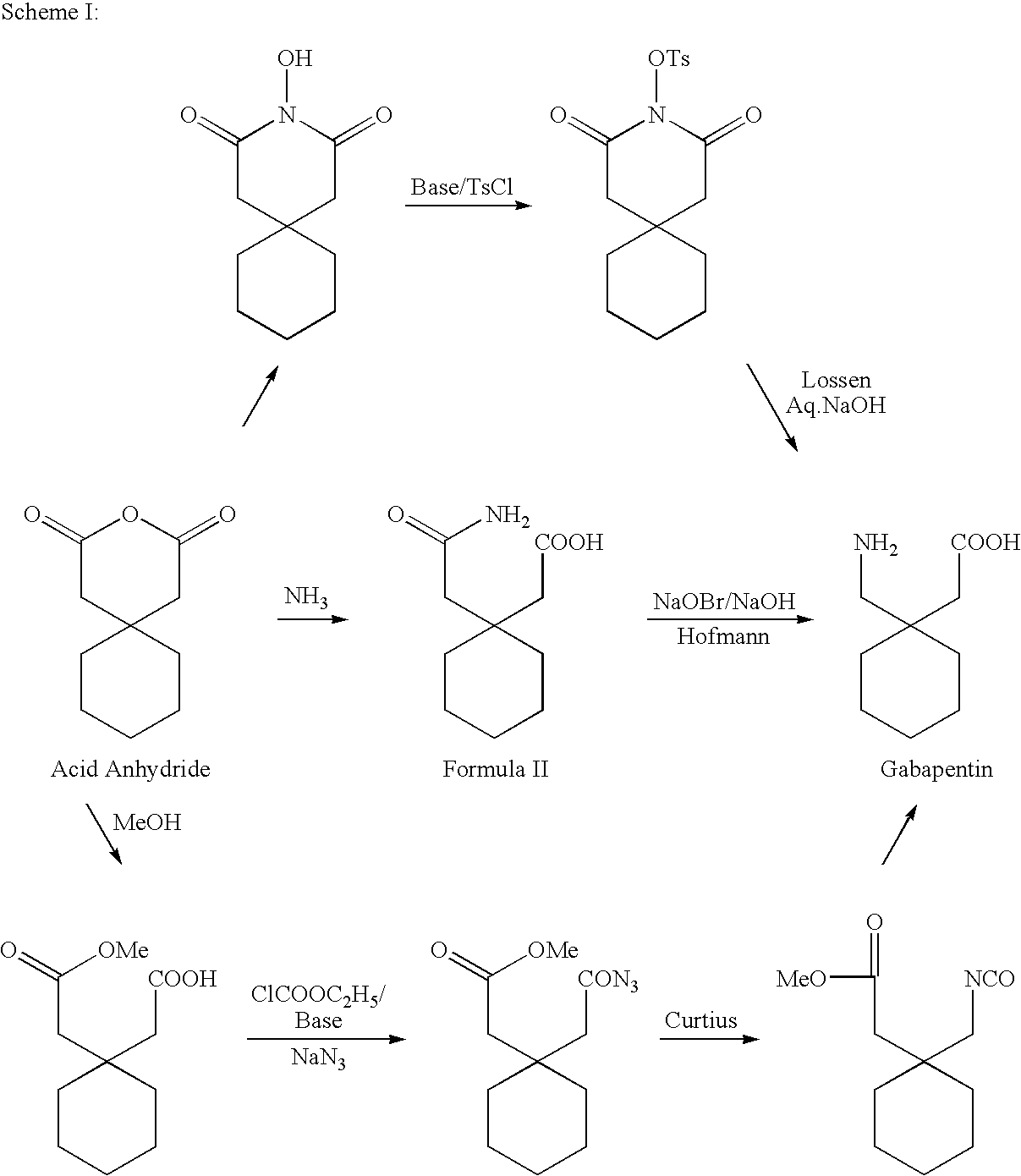Process For Synthesis Of Gabapentin
a technology of gabapentin and gabapentin powder, which is applied in the preparation of aminocarboxyl compounds, chemistry apparatus and processes, and organic chemistry, etc. it can solve the problems of process inability to large-scale production, and process inability to achieve large-scale production. , the effect of minimizing by-products/impurities, reducing production costs
- Summary
- Abstract
- Description
- Claims
- Application Information
AI Technical Summary
Benefits of technology
Problems solved by technology
Method used
Image
Examples
example 1
Preparation of 1,1-Cyclohexanediacetic Acid Monoamide
[0050]In 1.0 lit R B Flask charged water (135 ml), and ammonium chloride (161.6 g), under cooling. Aqueous sodium hydroxide solution (110 g in 200 ml water) was added drop wise under stirring maintaining temperature below 20° C. After complete addition the reaction mass was further maintained at 0-5° C. for 30 min. Charged 1,1-cyclohexane diacetic acid anhydride (100 gm) maintaining temperature below 5° C. Maintained the reaction mass for 2.0 hrs at about 0° C., then raised the temperature to 25-30° C. and maintained 2 hrs at room temperature. Adjusted pH of the solution to 2-3 with aqueous HCl. Cooled the reaction mass to 0° C., maintained for 1.0 hr, filtered the solid mass and washed with chilled water. Dried the wet cake to get 105 gm 1,1-Cyclohexanediacetic acid monoamide.
example 2
Preparation of 1,1-Cyclohexanediacetic Acid Monoamide
[0051]In 1.0 lit R B Flask charged Toluene (500 ml) and 1,1-cyclohexanediacetic acid anhydride (100 gm). Heated the reaction mixture to 35-40° C. and charged slowly ammonium carbonate (47 g). Raised the temperature gradually to 70° C. and maintained for 6-8 hrs at ˜70° C. Cooled the reaction mass to 0° C. and filtered the same. The solid obtained was taken in water and adjusted the pH to 2-3 with conc. HCl. The solution was cooled to 0° C. and maintained 2-3 hrs, filtered and washed with chilled water. Dried the wet cake to get 107 g 1,1-Cyclohexane diacetic acid monoamide.
example 3
Preparation of 1,1-Cyclohexanediacetic Acid Monoamide
[0052]In 1.0 lit R B Flask charged 600 ml 12-14% ammonia solution in isopropyl alcohol and cooled to 0° C. Slowly charged 1,1-cyclohexanediacetic acid anhydride (100 g) maintaining temperature below 5° C. Stirred 1.0 hr after complete addition and raised the temperature to room temperature. Then cooled to 15-20° C. and adjusted the pH to 2-3 with aq. HCl solution. The reaction mass was stirred further for about 15 hrs, Filtered and washed the solid with chilled water. Dried the wet cake to get 95 g 1,1-Cyclohexanediacetic acid monoamide.
[0053]The filtrate was further concentrated to recover second crop 7 g.
PUM
| Property | Measurement | Unit |
|---|---|---|
| Volume | aaaaa | aaaaa |
| Purity | aaaaa | aaaaa |
| Crystallization enthalpy | aaaaa | aaaaa |
Abstract
Description
Claims
Application Information
 Login to View More
Login to View More - R&D
- Intellectual Property
- Life Sciences
- Materials
- Tech Scout
- Unparalleled Data Quality
- Higher Quality Content
- 60% Fewer Hallucinations
Browse by: Latest US Patents, China's latest patents, Technical Efficacy Thesaurus, Application Domain, Technology Topic, Popular Technical Reports.
© 2025 PatSnap. All rights reserved.Legal|Privacy policy|Modern Slavery Act Transparency Statement|Sitemap|About US| Contact US: help@patsnap.com



